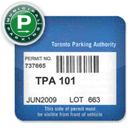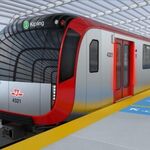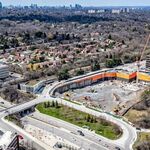W. K. Lis
Superstar
Meanwhile...
Last edited:
Meanwhile...
Just to chime in about the bike lanes on the recently revamped stretch of Bloor W, b/t Spadina and Bathurst: I was under the misapprehension that they'd be separated. They're not. They're 'permanent'. But the north side is a painted line, and the south side is a painted line/raised curb where there is parking and bus pick ups.
I'm pretty disappointed.
Thanks for chiming in. But I don't follow entirely, since there is no on-street parking on the north side of Bloor anyways. So it's just not clear to me why this lane wouldn't be separated by a curb.Essentially, wherever there was a buffer and bollards before the reconstruction, there is now a raised cycle track. There are a few sections where they couldn’t fit the chosen design for the raised cycle track, so those will remain painted buffer and bollards (but have not been installed yet). Anywhere that was previously paint-only will remain so, though it is said that the City has “future-proofed” those sections to make it easier and less costly to upgrade them to raised cycle tracks when, at some undetermined point in the future, it will be considered to be politically palatable to remove street parking spots in favour of protected bike infrastructure (yes, endless head desk).
Thanks for chiming in. But I don't follow entirely, since there is no on-street parking on the north side of Bloor anyways. So it's just not clear to me why this lane wouldn't be separated by a curb.
Informative, thanks a lot. I spose I figured it had something to do with this, but actually wasn't sure that the political considerations would be overriding the 'permanent' lanes. Ah well.Totally fair question, and one to which I know the answer only because I've heard it directly from the engineers who worked on the design. The reason is two related elements of the City's design guidelines: the minimum required lane width for emergency vehicle clearance, and the minimum required lane width for cycle tracks to account for the clearance needed for the small(er) snowplow that the City uses to clear its (few) cycle tracks.
Essentially, because of the total width of the curb-to-curb ROW -- and the fact that on-street parking is being kept on the south side -- by the City's guidelines, there isn't room to fit a protected cycle track on the north side where there is parking on the south side. If the south side street parking wasn't being kept, they could have nudged the centre line south a bit to create enough room for a cycle track on the north side, but parking removal unfortunately remains a third rail even along the second-most trafficked bike route in the city in a ward with a very pro-cycling councillor.
Layton has been dealing with a number of frustrated cyclists (and, I suppose, non-cyclists who happen to care about their fellow road users not dying) who have expressed their (valid) disappointment; his response has been to explain the "future-proofing" bit.
Protected bike lanes, protected intersections, contraflow bike lanes–think of some top-notch, quick-build bicycle infrastructure, and San Jose’s got it.
In the past year, the city has laid down ten miles of quick-build protected bike lanes. Some are parking protected. Some are protected by rows of robust-looking K71 plastic bollards. San Jose’s quick-build scheme costs the city only $1.5 million for an impressive transformation of the downtown core. Vignesh Swaminathan, a consultant who helped design the city’s quick-build network, explained that they saved money by making the installations a part of planned repaving.
Unlike in San Francisco and other Bay Area cities, the new protected bike lanes are nearly all joined by protected intersections.

“Motorists and cyclists still get startled by them,” explained Peter Bennett, who is in charge of the Bike and Pedestrian Program for San Jose. But he said they’re learning how to navigate the new set-up–and it’s working to reduce collisions. “Some people perceive it as inviting a right hook, but it’s about a negotiation.”
The idea is to force cars to slow down and make a tight turn–and to shift the relative angles of motorists and cyclists so they can make eye contact. “The treatment tries to induce a yield–and fifty percent of the time it’s the cyclist that needs to slow,” explained Bennett. Because of the treatments, both the motorists and cyclists have ample time to react to potential conflicts. In addition, the stop line for bikes is always placed far in front of the stop line for automobiles, to make cyclists more visible to drivers and to give them a head start across intersections.
Streetsblog recently covered the protected intersection pilot treatments in Berkeley, San Francisco, and Oakland. The San Jose design has the most in common with Oakland, since both use K71 plastic bollards and paint as an inexpensive, interim treatment. But San Jose has an added feature: Bennett and Swaminathan stressed that it’s essential to have two marked radii, or guidelines, for drivers making the turn.

Some of San Francisco’s treatments have an outer radius on turns, but they’re only marked by paint. Oakland’s protected intersections at Lake Merritt have only one radius. In San Jose, the outer radius includes the equivalent of Botts’ dots–raised pavement markings that make noise if a car or truck tire drives over them. This warns the motorist that they’re taking the turn too tightly and/or need to slow down. “If a truck is turning too tight, the driver feels the bumps,” explained Bennett. In addition, the geometries are set up so the apron of the truck or bus can pass over the bumps without the vehicle taking out the plastic vertical bollards that mark the inner radius (see diagrams above).

And those bollards are set back far enough to keep cyclist or pedestrians from ending up in the truck’s blind spot. They’ve also measured to make turns “as uncomfortable for truck drivers as possible.” Bennett and Swaminathan explained that they did this by emulating minimum clearances at construction sites. “Truck drivers are trained to navigate them,” said Swaminathan (who also gave Streetsblog a full tour of the infrastructure).
All of this may explain why Oakland’s protected intersections, which lack that additional, dotted radius, had squashed bollards shortly after it opened, while San Jose’s seem to be holding up better.
San Jose also made sure that bus stops were built with raised bike lane cut-throughs, as seen below:

The city used the same kind of quick-build bus stop islands that Oakland used on Telegraph. But Swaminathan said they upped the game by adding bollards to make sure cyclists didn’t ride into the drainage channel against the curb. They also added safety railings and leveled the island with two-by-fours and some asphalt underneath, to greatly reduce the risk of someone in a wheel chair rolling off the platform and into the bike lane–or of a blind person mistakenly navigating into the path of a bike...


Layton may be pro-cyclist but he also represents a Ward full of people. In that cross section don’t you think there are people who care about street parking? I would bet he probably gets more complaints about loss of street parking from locals than he does people advocating for separated bike lanes. That would make his perception of his battle for cycle infrastructure different from how theoretical advocate outsiders would view it from a distance.





